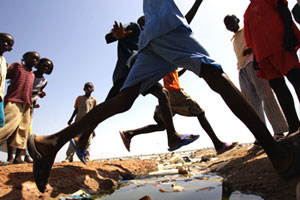News
Giving Young People the Opportunities and the Priority they Deserve
- 08 February 2008
News
NEW YORK — The aspirations, skills, rights, opportunities and health of young people are a top piority for UNFPA.
“This generation of young people is the largest in world history,” UNFPA Executive Director Thoraya A. Obaid told her organization at its 2007 Global Meeting. “We will fail them and ourselves if we do not embrace them and their dreams for a better future.

“Making youth a priority is not an option," she continued. "It is a necessity." The actions of young people will determine whether development succeeds or fails, she added.
UNFPA’s work on young people aims to unlock the full potential of adolescents and youth, so that they can enjoy this period of their lives even as they prepare to take on greater responsibilities.
Sexual and reproductive health issues are key concerns, yet so are education, livelihoods, and citizenship. In particular, UNFPA will advocate for increasing multi-sectoral investments in young people (health, education, and livelihoods) as part of each country’s poverty reduction strategy.
UNFPA has adopted a four-pronged framework for addressing the needs of youth broadly and holistically. This includes using data to advocate for youth-supportive policies, ensuring access to youth-friendly health services, fostering educational opportunities, with an emphasis on lifetime skills, and giving young people the chance to participate in decisions that affect them. In all these areas, the Fund pays particular attention to marginalized groups, particularly adolescent girls and young people caught in conflict zones.
![]()
Y-PEER: Building the Human Infrastructure for Social Change
NEW YORK — On three separate time lines taped to the walls of a conference centre in upstate New York, members of the Global Advisory Panel of Y-PEER wrote down events that had shaped their own lives, the world and the course of the HIV epidemic over the last quarter century.![]() More
More